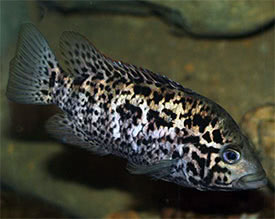
 Magyarul / Hungarian
Magyarul / Hungarian



- Scientific name: Scleropages jardinii
- Synonyms: Osteoglossum jardinii (Saville-Kent, 1892)
- Common name: Australian bonytongue
- Group: Other fishes
- Habitat: Australia, Indonesia, Papua New Guinea
- Size: 90 cm, but usually smaller in aquarium (55 cm)
- Biotope: Found in slow-moving rivers, lakes, and swamps usually in clear water with surface vegatation or overhanging terrestrial vegetation.
- Social behavior: An aggressive and highly territorial fish that will eat smaller fish, so if you would like to keep them in a community tank, choose large tankmates (catfish, cichlids). However some individuals won’t tolerate any tankmates, so they should be kept singly.
- Diet: Carnivorous; They can be fed with small fish, earthworms, mussels, prawns and other frozen foods.
- Breeding: Very rare in aquarium.
- Tank: Minimum 1000 litres
- Population: 1 fish for 1000 litres
- Decoration: They require a huge aquarium with a lot of swimming space and decor is not really critical. Filtration needs to be efficient, as if the fish are kept in poor water conditions they can develop problems with their eyes and gills, thus regular water changes are essential. Theri tank must be covered.
- Temperature: 24-29 °C
- pH: 6.8-7.5
- Hardness: 8-15 NK°
- Lifespan: 8-12 years
Description: Australian bonytongue has a long, laterally compressed, dark grey or bronze colored body with 7 rows of scales. At the end of each scale there are several reddish dots making a crescent shape. The fins are dark grey and speckled with small reddish spots. They have large upturned mouth with 2 barbels on the lower lip. Their gill covers are also covered with a pattern of red lines and dots. The dorsal fin is positioned posteriorly on the body close to the caudal fin. The number of scales in the lateral line is 32-35 in contrast with their relative the Asian Arowana (Scleropages formosus), which has only 21-25 scales. Australian bonytongue can be easily distinguished from the asian species by its much smaller scale size, and duller patterning. Take care that the pH of the water does not rise above 7.5, as it can cause problems with they eyes of the fish. In their natural habitat Scleropages jardinii are an important food fish, and because the adult fish can weigh 12 to 27 kg, they are also popular among anglers.
Males have a longer anal fin. The breeding of Scleropages jardinii is infrequent in the aquarium, but is being spawned in fairly large numbers on Far-Eastern fish farms. This can be obvious, as a really huge aquarium would be needed to breed this fish, whereas the fish farms have outdoor ponds to spawn the fish. Spawning occurs durind the rainy season from September to early November when daytime surface temperatures approach 30°C. Australian bonytongue is a mouthbrooding species, but unlike with the asian species it is the female who cares for the brood. The number of the eggs can vary from 50 to 200, and the larvae hatch at 1-2 weeks, and remain with the female for another 4-5 weeks, leaving her mouth only to forage. In times of danger she will open her mouth allowing the young to seek shelter. Slowly the fry begin to spend more and more time away from the adult fish, until they are large enough to fend for themselves. At this point the fry usually 3.5-4 cm long.












